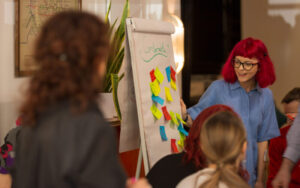In leadership and team dynamics, the term masculinity has often been associated with traits like decisiveness, strength, and authority. While these qualities are valuable, they are frequently framed as being incompatible with relational qualities such as empathy, care, and connection. This false dichotomy not only limits the potential of leadership but also perpetuates workplace cultures that prioritise action over intention, and short-term wins over long-term success.
What if masculinity could be reframed? What if it could embody both power and purpose, action and care, strength and connection? Intentional masculinity does just that. It integrates masculine energy with feminine traits like emotional intelligence, collaboration, and curiosity, creating a balanced approach that inspires growth, inclusion, and sustainable success.
This blog explores what intentional masculinity looks like, how the feminine voice informs and enhances leadership, and how tools like ORSC’s Designed Team Alliances (DTA) can help teams create environments of respect, care, and shared accountability.
What Does Intentional Masculinity Look Like?
Intentional masculinity redefines traditional leadership by grounding traits like decisiveness and action in love, care, and respect. It’s about leading with purpose and creating impact without leaving others behind.
Characteristics of Intentional Masculinity in Leadership:
- Strength with Empathy: Leaders remain decisive and action-oriented but take the time to understand the emotional needs of their teams.
- Power with Care: Leaders use authority to uplift others, fostering collaboration and shared success rather than domination.
- Ambition with Purpose: Instead of chasing short-term results, intentional masculinity focuses on long-term growth and collective well-being.
How the Feminine Voice Informs Intentional Masculinity
The feminine voice brings balance and intention to masculine energy by introducing qualities that prioritise relationships and long-term thinking.
- Emotional Intelligence: Feminine energy emphasises understanding and managing emotions—both one’s own and those of others. This awareness allows leaders to navigate challenges with empathy and care.
- Example: A leader facing resistance to change can use emotional intelligence to address team concerns, fostering trust rather than forcing compliance.
- Relational Focus: The feminine voice centres on connection and collaboration, ensuring that individual and team success are intertwined.
- Example: Instead of focusing solely on performance metrics, a leader might prioritise team-building activities that strengthen relationships and enhance morale.
- Long-Term Vision: Feminine energy encourages leaders to take a broader view, prioritising sustainability over quick wins.
- Example: A company leader might forgo immediate profit to invest in training programs that ensure long-term employee engagement and innovation.
When masculine energy is informed by these feminine traits, leadership transforms. Decisiveness becomes grounded in care, and action is tempered by intentionality.
Misconceptions About Masculinity in Leadership
The idea that masculinity is inherently aggressive or incompatible with love stems from cultural stereotypes. Masculinity is often depicted as transactional, competitive, or emotionally detached.
Breaking the Myths:
- Masculinity is Aggressive: True masculinity is not about overpowering others but about using assertiveness to create structure and clarity.
- Masculinity Lacks Emotion: Masculinity, when informed by the feminine, recognizes that vulnerability and emotional awareness are strengths, not weaknesses.
- Masculinity is Inherently Competitive: Intentional masculinity fosters collaboration by balancing competition with inclusion and fairness.
Reframing these narratives allows masculinity to become a force for inclusion, growth, and innovation.
Using ORSC Tools to Embed Intentional Masculinity in Leadership
The ORSC methodology offers practical tools to help leaders balance masculine and feminine energies, creating environments that prioritise respect, care, and accountability.
1. Designed Team Alliances (DTA): Creating Intentional Agreements
DTAs help teams establish shared values and agreements about how they will work together. These agreements create a culture of intentionality, blending the masculine focus on structure with the feminine emphasis on collaboration and respect.
- How It Works: Teams co-create agreements that define how they will communicate, resolve conflicts, and support one another.
- Example: A team might agree to prioritise direct communication (masculine) while also committing to active listening and empathy (feminine).
2. MetaSkills: Guiding Leadership with Intention
MetaSkills are intentional attitudes or mindsets that guide how leaders approach challenges and relationships. Feminine MetaSkills like curiosity, compassion, and resilience balance masculine traits like ambition and decisiveness.
- How It Works: Leaders consciously adopt MetaSkills to guide their actions.
- Example: A leader might use the MetaSkill of curiosity during a heated debate, asking open-ended questions to better understand differing perspectives instead of reacting defensively.
3. The 3rd Entity: Focusing on the System
The 3rd Entity tool shifts the focus from individual perspectives to the collective needs and goals of the team system.
- How It Works: Leaders and teams explore what the “relationship system” needs, ensuring that decisions are made with the entire group in mind.
- Example: A leader managing conflict within a team might ask, “What does our team as a whole need to move forward?” rather than focusing solely on individual grievances.
The Benefits of Intentional Masculinity in Leadership
When masculinity is expressed with intention and informed by the feminine, it transforms teams, leaders, and organizations.
For Leaders:
- Authenticity: Leaders who balance strength with care feel empowered to show up as their full selves.
- Influence: By blending assertiveness with empathy, leaders earn trust and inspire loyalty.
For Teams:
- Psychological Safety: Teams thrive when leaders model care and connection, creating environments where individuals feel safe to contribute and take risks.
- Collaboration: Masculine traits like decisiveness are complemented by feminine traits like inclusivity, fostering stronger teamwork.
For Organisations:
- Sustainable Growth: Purpose-driven leadership ensures long-term success without sacrificing relationships or values.
- Positive Culture: Organisations that integrate love and intentional masculinity attract top talent and foster innovation.
Key Takeaways: Strength Meets Intention
Masculinity, when expressed with love and intention, is a transformative force in leadership. It blends the decisiveness and action of the masculine with the care, curiosity, and relational focus of the feminine.
Leaders who embody intentional masculinity create teams and organisations that thrive—not just in performance but in connection, inclusion, and long-term growth. Tools like Designed Team Alliances, MetaSkills, and The 3rd Entity offer practical ways to embed this balance into leadership and team dynamics.
Are you ready to lead with purpose and intention? Explore how ORSC can help you integrate love and masculinity into your leadership journey, creating environments where everyone thrives.






